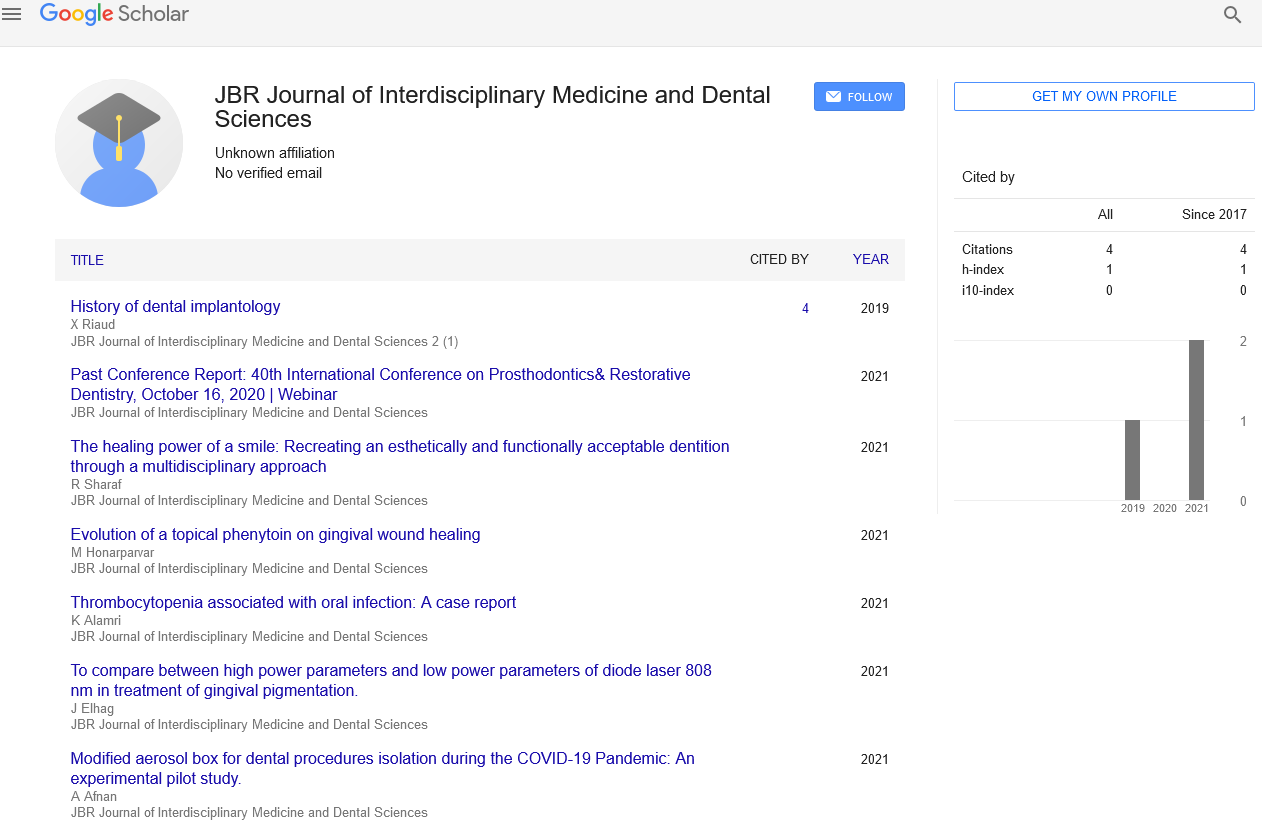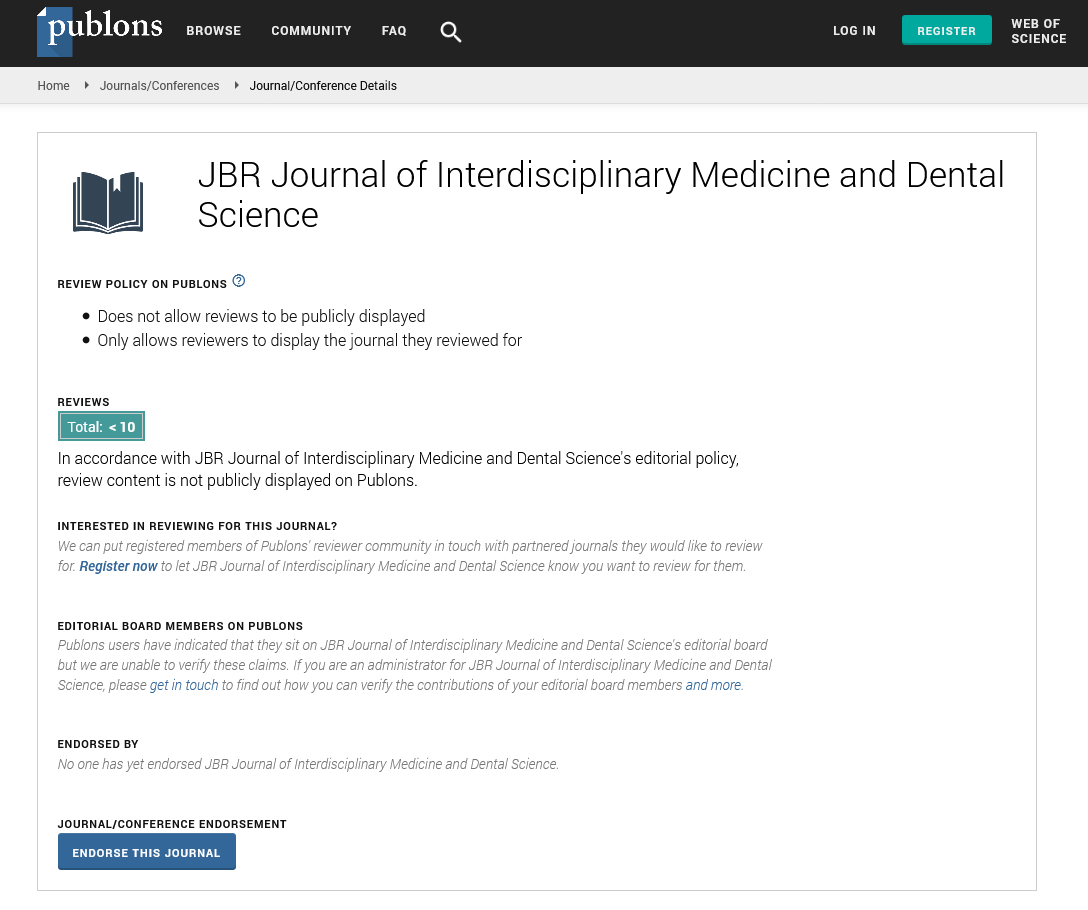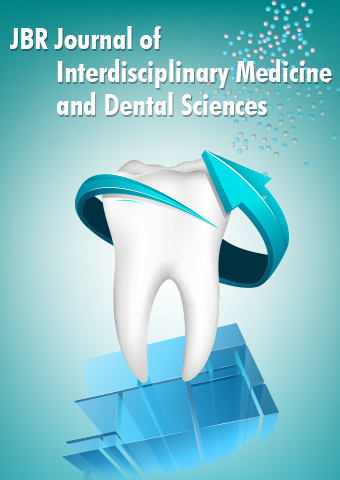Editorial - JBR Journal of Interdisciplinary Medicine and Dental Sciences (2023) Volume 6, Issue 3
Oral and Maxillofacial Surgery A Comprehensive Approach to Dental and Facial Care
Petersen Hook*
Petersen Hook
Petersen Hook
E-mail: p_hook@gmail.com
Received: 01-May-2023, Manuscript No. jimds-23-100134; Editor assigned: 04-May-2023, PreQC No. jimds-23-100134 (PQ); Reviewed: 19-May-2023, QC No. jimds-23-100134; Revised: 24-May-2023, Manuscript No. jimds-23-100134 (R); Published: 30-May-2023, DOI: 10.37532/2376- 032X.2023.6(3).46-48
Abstract
Oral and maxillofacial surgery is a specialized field of dentistry that encompasses the diagnosis and surgical treatment of conditions affecting the mouth, jaws, face, and neck. This branch of dentistry combines dental knowledge with medical and surgical expertise to provide comprehensive care to patients. Oral and maxillofacial surgeons are skilled in a wide range of procedures, including dental implant surgery, jaw surgery, wisdom teeth extraction, facial trauma reconstruction, TMJ disorder treatment, cleft lip and palate repair, and facial cosmetic surgery. They play a vital role in restoring oral health, improving facial function, and enhancing facial aesthetics. This article provides an overview of oral and maxillofacial surgery, highlighting the diverse scope of procedures and treatments performed by these highly trained professionals.
Keywords
Oral and maxillofacial surgery • Dental implant surgery • Wisdom teeth extraction • Facial anatomy
Introduction
Oral and maxillofacial surgery is a specialized field of dentistry that focuses on the diagnosis and surgical treatment of diseases, injuries, and defects affecting the mouth, jaws, face, and neck [1]. This branch of dentistry combines dental expertise with medical and surgical skills to provide comprehensive care for patients with complex oral and facial conditions. From routine dental procedures to complex reconstructive surgeries, oral and maxillofacial surgeons play a crucial role in restoring oral health, improving facial aesthetics, and enhancing overall well-being [2]. With their extensive knowledge of oral and facial anatomy, these skilled professionals are equipped to address a wide range of conditions, ranging from dental implant surgery and wisdom teeth extraction to jaw surgery and facial trauma reconstruction. In this article, we will delve into the scope of oral and maxillofacial surgery, exploring the various procedures and treatments offered by these highly trained specialists [3].
Discussion
Oral and maxillofacial surgery is a specialized field of dentistry that focuses on the diagnosis and surgical treatment of diseases, injuries, and defects affecting the mouth, jaws, face, and neck. It combines dental, medical, and surgical expertise to provide comprehensive care to patients [4]. From routine dental procedures to complex facial reconstructive surgeries, oral and maxillofacial surgeons play a vital role in restoring oral health and improving facial aesthetics. In this article, we will explore the scope of oral and maxillofacial surgery and its various procedures.
Scope of oral and maxillofacial surgery
Oral and maxillofacial surgeons are highly trained professionals who possess a deep understanding of the complex anatomy and function of the oral and facial structures [5].
They provide a wide range of services, including
Dental implant surgery- Dental implants are an excellent solution for replacing missing teeth. Oral and maxillofacial surgeons are skilled in implant placement procedures, ensuring optimal outcomes for patients seeking a permanent and natural-looking solution for tooth loss.
Jaw surgery
Orthogenetic surgery, commonly known as jaw surgery, is performed to correct functional and aesthetic issues caused by jaw misalignment [6]. This procedure can address problems such as a misaligned bite, facial asymmetry, sleep apnea, and difficulty in speaking or chewing.
Wisdom teeth extraction
Wisdom teeth, also known as third molars, often cause problems such as impaction, overcrowding, and infection. Oral and maxillofacial surgeons specialize in the safe and efficient removal of impacted or problematic wisdom teeth, preventing future oral health complications [7].
Facial trauma reconstruction
Oral and maxillofacial surgeons are trained to treat facial injuries resulting from accidents, sports-related incidents, or other traumatic events. They have the expertise to repair fractured facial bones, treat soft tissue injuries, and restore normal function and aesthetics [8].
TMJ disorders
Temporomandibular joint (TMJ) disorders can cause chronic pain and discomfort in the jaw joint and surrounding muscles. Oral and maxillofacial surgeons can diagnose and provide treatment options, ranging from conservative therapies to surgical interventions, to alleviate TMJ-related symptoms.
Cleft lip and palate repair
Cleft lip and palate are congenital conditions that affect the formation of the upper lip and roof of the mouth. Oral and maxillofacial surgeons work as part of a multidisciplinary team to perform corrective surgeries, helping children and adults achieve improved speech, swallowing, and facial appearance [9].
Facial cosmetic surgery
Oral and maxillofacial surgeons possess extensive knowledge of facial anatomy and aesthetics, making them well-suited to perform cosmetic procedures. They offer treatments such as facial rejuvenation, chin augmentation, and facial contouring to enhance facial features and improve self-confidence.
Oral and maxillofacial surgery: Refers to a specialized field of dentistry that focuses on diagnosing and surgically treating conditions related to the mouth, jaws, face, and neck.
Dentistry: The branch of medicine that deals with the diagnosis, prevention, and treatment of diseases and disorders of the oral cavity.
Surgical treatment: In the context of oral and maxillofacial surgery, it involves performing surgical procedures to address various oral and facial conditions.
Mouth: The opening in the lower part of the face used for eating, speaking, and breathing.
Jaws: The upper and lower bony structures in the mouth that hold the teeth and facilitate biting, chewing, and speaking.
Face: The front part of the head that includes the eyes, nose, mouth, and chin.
Neck: The part of the body that connects the head to the rest of the torso.
Dental implant surgery: A procedure that involves the placement of artificial tooth roots (dental implants) into the jawbone to support replacement teeth [10].
Jaw surgery: Also known as orthographic surgery, it is performed to correct jaw misalignment and address functional and aesthetic issues related to bite, facial symmetry, and overall oral health.
Wisdom teeth extraction: The removal of third molars (wisdom teeth) that often cause problems such as impaction, overcrowding, and infection.
Facial trauma reconstruction: The surgical repair and restoration of facial structures damaged due to accidents, sports injuries, or other traumatic incidents.
TMJ disorders: Temporomandibular joint disorders involve problems with the jaw joint, leading to pain, clicking, and difficulty in jaw movement. Oral and maxillofacial surgeons provide treatment options to alleviate these conditions.
Cleft lip and palate repair: Surgical procedures performed to correct congenital conditions that affect the upper lip and roof of the mouth (cleft lip and palate), improving speech, swallowing, and facial appearance.
Facial cosmetic surgery: Procedures aimed at enhancing facial aesthetics, including facial rejuvenation, chin augmentation, and facial contouring, performed by oral and maxillofacial surgeons with expertise in facial anatomy.
Oral health: The condition of the mouth and its components, including teeth, gums, and other supporting structures.
Facial aesthetics: The visual appeal and harmony of facial features, including symmetry, proportions, and overall appearance.
Dental expertise: The specialized knowledge and skills related to the diagnosis and treatment of dental conditions and oral health.
Medical skills: The comprehensive understanding of medical principles and techniques required for diagnosing and treating oral and maxillofacial conditions.
Comprehensive care: A holistic approach that considers various aspects of oral and facial health, including diagnosis, treatment, and postoperative care.
Surgical interventions: Medical procedures involving incisions, manipulations, or alterations to address specific conditions or achieve desired outcomes in oral and maxillofacial surgery.
Conclusion
Oral and maxillofacial surgery encompasses a broad range of procedures aimed at improving oral health, restoring function, and enhancing facial aesthetics. Oral and maxillofacial surgeons undergo rigorous training, which includes both dental and medical education, to provide comprehensive care to their patients. Whether it’s a routine tooth extraction or complex facial reconstruction, these specialists are equipped with the knowledge and skills to deliver optimal outcomes. If you have any dental or facial concerns that require surgical intervention, consulting an oral and maxillofacial surgeon can be the first step towards a healthier smile and a more confident you.
References
- Kuliev A, Verlinsky Y. Preimplantation diagnosis: A realistic option for assisted reproduction and genetic practice. Curr Opin Obstet Gynecol. 17, 179-183 (2005).
- Williams TN. Obaro SK Sickle cell disease and malaria morbidity: a tale with two tails. Trends in Parasitology. 27, 315-320 (2011).
- Kumar P, Radhakrishnan J, Chowdhary MA et al. Prevalence and Patterns of Presentation of Genetic Disorders in a Pediatric Emergency Department. Mayo Clinic Proceedings. 76, 777-783 (2001).
- Bick D, Bick SL, Dimmock DP et al. An online compendium of treatable genetic disorders. American Journal of Medical Genetics. Part C, Seminars in Medical Genetics. 187, 48-54 (2021).
- Lvovs D, Favorova OO, Favorov AV et al. A Polygenic Approach to the Study of Polygenic Diseases. Acta Naturae. 4, 59-71 (2012).
- Yoshiura K, Kinoshita A, Ishida T et al. A SNP in the ABCC11 gene is the determinant of human earwax type. Nat Genet. 38, 324-330 (2006).
- Allison AC. Genetic control of resistance to human malaria. Current Opinion in Immunology. 21, 499-505 (2009).
- Perkins BA, Ficociello LH, Silva KH et al. Regression of microalbuminuria in type 1 diabetes. N Engl J Med. 348, 2285-2293 (2003).
- Sadeghi M. Fracture strength and bending of fiber-reinforced composites and metal frameworks in fixed partial dentures.Frontiers in Dentistry. 99-104 (2008).
- Rabie ZH. Effect of Fiber Reinforcement on Fracture Resistance and Fracture Toughness for Long Span Provisional Restorations.Egyptian Dental Journal. 2491-2502 (2019).
Indexed at, Google Scholar, Crossref
Indexed at, Google Scholar, Crossref
Indexed at, Google Scholar, Crossref
Indexed at, Google Scholar, Crossref
Indexed at, Google Scholar, Crossref
Indexed at, Google Scholar, Crossref
Indexed at, Google Scholar, Crossref
Indexed at, Google Scholar, Crossref


